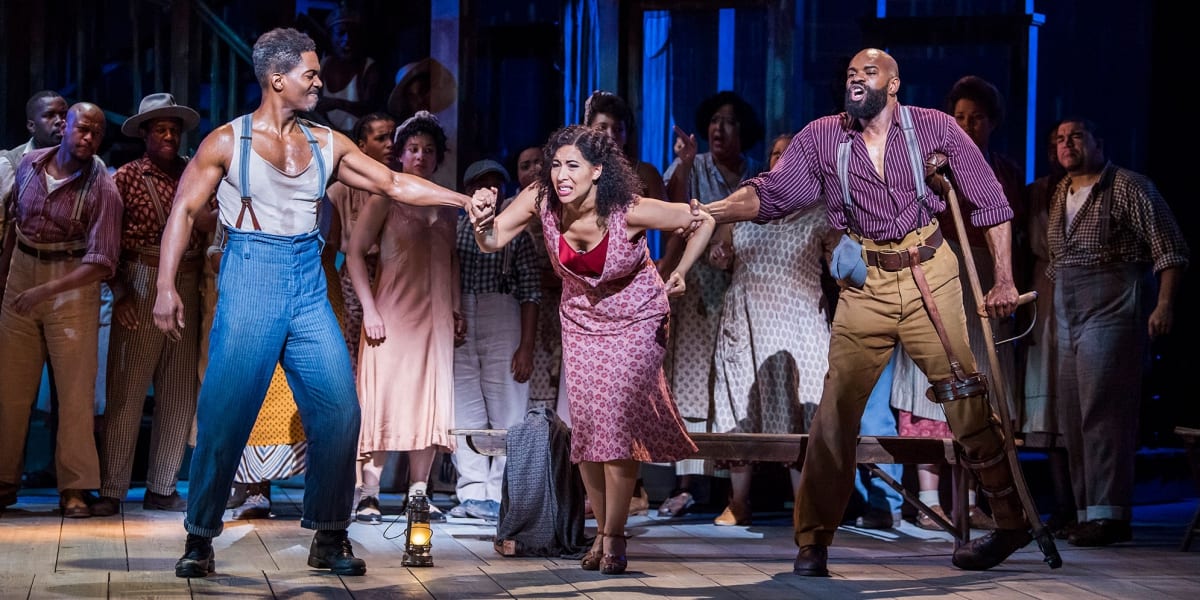This stunning production of Porgy and Bess, is the outstanding efforts of an ensemble of 40 singers, in a unique three way co-production between ENO, Dutch National Opera and the New York Met. The director, James Robinson ( Nixon In China), together with the American conductor John Wilson, lead the excellent artistic team.
Michael Yeargan’s set is jaw droopingly evocative. A wooden skeletal structure, which we can see through like a giants dolls house, which moreover revolves to show multiple viewpoints, takes us into the world of Catfish Row, a tenement block in Charleston, South Carolina in the 1920s. Then we hear that famous opening line “Summer time and the living is Easy “ with a 40 strong black cast on stage, in that set, in those fantastic costume’s, accompanied by the ENO Orchestra and to me it felt that all was the best in the best of all possible worlds. Just as important it marked a moment when a black company could own the stage at the Coliseum. The lip service about Opera for all was for once made tangible in action. Moreover it’s not tokenism. This is opera of the highest quality. So well done to ENO for having the vision to put this on stage. Sadly it was still an overwhelmingly white audience. Black faces were too few. But as in art imitating life so this lack of black faces in the audience was in many ways also central to the drama going on stage.
The sociology of Porgy and Bess is extraordinary. Although George and Ira Gershwin wrote it in 1935 and set it back in the 1920s the “issues” are utterly topical in 2018. Black people living in socially segregated communities such as Catfish Row, check, Black on black violence( Crown killing Robbins), check, alcohol and drugs ( Happy Dust aka Cocaine) widely used as an escape from despair, check, white police brutality, check, young girls seduced via drugs into prostitution ( Sportin’ Life taking Bess off to New York to buy her a mansion). In these and many other ways Porgy and Bess is as pertinent now as it was in 1935.
As a work of Art what I found most intriguing about Porgy and Bess is the way in which the psychological states of mind of each character were drawn out with such subtlety and nuance. Nicole Cabell’s Bess captured her conflicted inner struggles. She loves Porgy and wants to settle down with him. But there is something about Crown when he touches her ( “He Hypnotises Me)that she is powerless to resist. A part of her longs for the excitement that Crown offers. She wants him. She turns back and obeys when he says“ get in that thicket” as he takes his trousers off. She follows him because she wants more.
The orchestra’s performance of this brilliant music, under the baton of John Wilson, is superb, creating a seamless dialogue between the singer on stage and musicians in the pit. The singing is exquisite. Latonia Moore’s lament for her dead Husband Robbin’s “My Man Gone Now” which she sung lying on and caressing his plain coffin, is particularly moving. Eric Greene is just perfect as Porgy. He captures the reality of his life as a “ crippled “ beggar ( with his cart, crutches and leg brace) without falling into the trap of sentimentality. His wonderful resilience and zest for life as expressed in “ oh I got plenty O nuttin “ and his courage and fortitude as when he strangles Crown. His love for Bess is expressed on the one hand by the red dress he buys her and on the other by his determination to push his cast 1,000 miles to New York to find her.
A must see, if possible.

